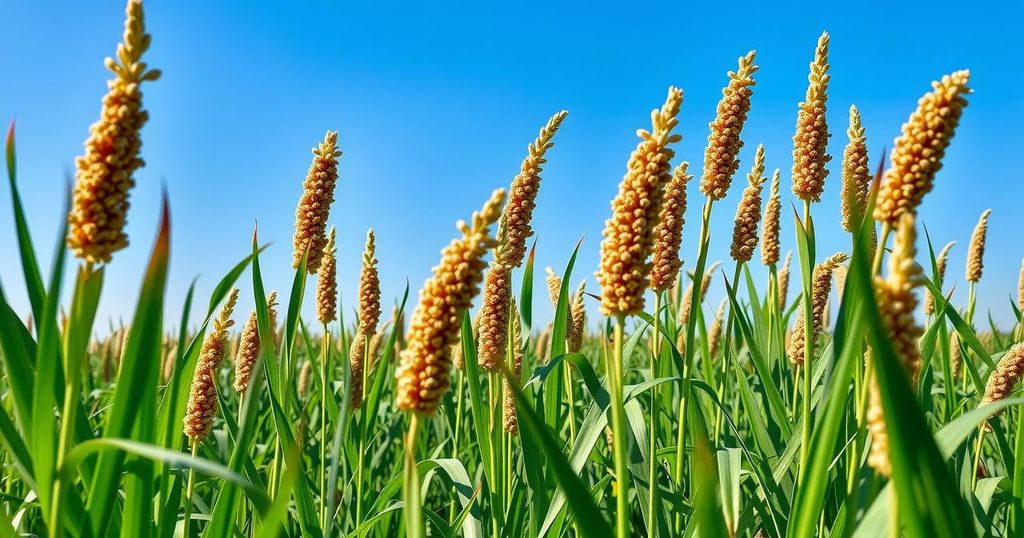Sorghum is being promoted as a viable alternative to maize in Africa to address food security amid climate change. With a remarkable drought resilience and lower water requirements, sorghum stands out nutritionally and economically. Initiatives by organizations like Sorghum United aim to overcome barriers to adoption, fostering consumer awareness and encouraging governmental support for the grain’s cultivation.
For many years, African nations have relied heavily on maize as the foundation of their diets. However, climate change has exacerbated maize’s susceptibility to drought and erratic rainfall, prompting experts to promote sorghum as a superior alternative. This ancient grain holds significant potential for sustainable agriculture and enhancing food security across the continent.
Nate Blum, CEO of Sorghum United, advocates for a paradigm shift towards sorghum. He emphasizes, “Sorghum is the future of agriculture. It’s a climate-smart crop that not only withstands extreme conditions but also offers unparalleled benefits for nutrition, soil health, and economic sustainability.” Unlike maize, which struggles during drought, sorghum has a remarkable ability to remain dormant when water is scarce and resume growth once moisture returns.
Additionally, sorghum’s lower water requirements present a key advantage, needing as little as one-tenth of the water that maize demands. Blum highlights, “Many parts of the world are battling inconsistent and extreme weather events. Sorghum and millets offer common-sense solutions to our global food security and climate challenges.”
In terms of nutritional value, sorghum excels with higher fiber, protein, and essential micronutrients compared to maize. Being gluten-free and possessing a low glycemic index, it serves as a healthier choice for consumers. Blum states, “Sorghum isn’t just food—it’s an opportunity. It can be ground into flour, popped like popcorn, used in biodegradable packaging, and even as an alternative to carbon fiber.” This versatility allows farmers to diversify their income sources and decreases reliance on fluctuating commodity markets.
Despite its advantages, smallholder farmers in Africa face obstacles such as limited market access and mechanization when adopting sorghum. Sorghum United is proactive in addressing these challenges through field-to-market trials in nations like Kenya, Zimbabwe, Tanzania, Malawi, and South Africa. Blum asserts, “We don’t just introduce solutions—we empower local farmers to create their own.”
To establish sorghum as a mainstream crop, enhancing consumer awareness is essential. Sorghum United is implementing educational initiatives, including children’s books and video games, as well as utilizing celebrity endorsements at significant events like the Oscars, as stated by Blum.
Furthermore, it is vital for governments to invest in policies supportive of sorghum cultivation. Blum argues, “Public health education on these grains is essential. Two-thirds of diseases are diet-related. With sorghum, we can turn the tide.” Thus, sorghum offers a sustainable alternative for a continent historically reliant on maize, often resulting in adverse outcomes.
Ultimately, sorghum represents more than merely a crop. As Blum summarizes, “It’s about empowering farmers, protecting the environment, and ensuring a healthier future for generations to come.” With appropriate policies, investments, and a push for awareness, sorghum might well transform African agriculture and bolster food security amidst an uncertain climate.
In conclusion, sorghum emerges as a promising solution to Africa’s food security challenges, presenting substantial benefits in resilience to climate change, nutritional value, and economic diversification. While challenges remain in terms of farmer adoption and market access, initiatives from organizations like Sorghum United are pivotal. By fostering awareness and implementing supportive policies, there lies potential for sorghum to revolutionize agriculture across the continent, ensuring a more sustainable future.
Original Source: www.nyasatimes.com




